CARL THOMAS THORNTON
Civilian Conservation Corps

History in Words and Photos
| 04/13/14 |
THORNTON GENEALOGY PROJECT 2011
From Wikipedia, the free encyclopedia
Civilian Conservation Corps (CCC)
was a public work relief program that operated from 1933 to 1942 in the
United States for unemployed, unmarried men from relief families, ages
18–25 as part of the New Deal. Robert Fechner was the head of the
agency. It was a major part of President Franklin D. Roosevelt's New Deal
that provided unskilled manual labor jobs related to the conservation and
development of natural resources in rural lands owned by federal, state
and local governments. The CCC was designed to provide jobs for young men,
to relieve families who had difficulty finding jobs during the Great
Depression in the United States while at the same time implementing a
general natural resource conservation program in every state and
territory. Maximum enrollment at any one time was 300,000; in nine years 3
million young men participated in the CCC, which provided them with
shelter, clothing, and food, together with a small wage of $30 a month
($25 of which had to be sent home to their families).[1]
The American public made the CCC
the most popular of all the New Deal programs.[2] Principal benefits of an
individual's enrollment in the CCC included improved physical condition,
heightened morale, and increased employability.[3] Implicitly, the CCC
also led to a greater public awareness and appreciation of the outdoors
and the nation's natural resources; and the continued need for a carefully
planned, comprehensive national program for the protection and development
of natural resources.[4]
During the time of the CCC,
volunteers planted nearly 3 billion trees to help reforest America,
constructed more than 800 parks nationwide and upgraded most state parks,
updated forest fire fighting methods, and built a network of service
buildings and public roadways in remote areas.[5]
The CCC operated separate
programs for veterans and Native Americans.
Despite its popular support, the
CCC was never a permanent agency. It depended on emergency and temporary
Congressional legislation for its existence. By 1942, with World War II
and the draft in operation, need for work relief declined and Congress
voted to close the program.[7]
Founding
As governor of New York,
Roosevelt had run a similar program on a much larger scale. Long
interested in conservation,[8] as president, he proposed to Congress a
much larger national program on 21 March 1933:[9]
I propose to create [the CCC] to
be used in complex work, not interfering with abnormal employment, and
confining itself to forestry, the prevention of soil erosion, flood
control and similar projects. I call your attention to the fact that this
type of work is of definite, practical value, not only through the
prevention of great present financial loss, but also as a means of
creating future national wealth.
He promised this law would
provide over 9000 young men with meals, housing, uniforms, and medical
care for working in the national forests and other government properties.
The Emergency Conservation Work (ECW) Act was introduced to Congress the
same day and enacted by voice vote on 31 March. Roosevelt issued Executive
Order 6101 on 5 April 1933 which established the CCC organization and
appointed a director, Robert Fechner, a former labor union official who
served until 1939. The organization and administration of the CCC was a
new experiment in operations for a federal government agency. The order
indicated that the program was to be supervised jointly by four government
departments: Labor, which recruited the young men, War, which operated the
camps, Agriculture and Interior, which organized and supervised the work
projects. A CCC Advisory Council was composed of a representative from
each of the supervising departments. In addition, the Office of Education
and Veterans Administration participated in the program. To end the
opposition from labor unions (which wanted no training programs started
when so many of their men were unemployed)[10] Roosevelt chose Robert
Fechner, vice president of the American Machinists Union, as director of
the corps. William Green, head of the American Federation of Labor, was
taken to the first camp to demonstrate that there would be no job training
involved beyond simple manual labor.[11]
US Army
Reserve officers from the U.S.
Army were in charge of the camps, but there was no military training.
General Douglas MacArthur was placed in charge of the program[12] but
stated that the number of Army officers and soldiers assigned to the camps
was affecting the readiness of the Regular Army.[13]
Early Years, 1933–1934
The legislation and mobilization
of the program occurred quite rapidly. Roosevelt made his request to
Congress on March 21, 1933; the legislation was submitted to Congress the
same day; Congress passed it by voice vote on 31 March; Roosevelt signed
it the same day, then issued an executive order on April 5 creating the
agency, appointing its director (Fechner), and assigning War Department
corps area commanders the task to commence enrollment. The first CCC
enrollee was selected 8 April and subsequent lists of unemployed men were
supplied by state and local welfare and relief agencies for immediate
enrollment. On 17 April the first camp, NF-1, Camp Roosevelt,[14] was
established at George Washington National Forest near Luray, Virginia. On
18 June, the first of 161 soil erosion control camps was opened, in
Clayton, Alabama.[15] By 1 July 1933 there were 1,463 working camps with
250,000 junior enrollees (18–25 years of age), 28,000 veterans, 14,000
American Indians, and 25,000 Locally Enrolled (or Experienced) Men (LEM).[16][17]
Enrollees
The typical CCC enrollee was a
U.S. citizen, unmarried, unemployed male, 18–25 years of age. Normally
his family was on local relief. Each enrollee volunteered and, upon
passing a physical exam and/or a period of conditioning, was required to
serve a minimum six-month period with the option to serve as many as four
periods, or up to two years if employment outside the Corps was not
possible. Enrollees worked 40 hours a week over five days, sometimes
including Saturdays if poor weather dictated. In return they received $30
a month with a compulsory allotment $22–25 sent to a family dependent,
as well as food, clothing and medical care.[18] Following the second Bonus
Army march on Washington D.C., President Roosevelt issued Executive Order
6129 (11 May 1933) to amend the CCC program, to include work opportunities
for veterans. Veteran qualifications differed from the junior enrollee;
one needed to be certified by the Veterans Administration by application,
they could be any age, and married or single as long as they were in need
of work. Veterans were mostly assigned to entire veteran camps.[19]
Enrollees were eligible for "rated" positions to help with camp
administration: senior leader, mess steward, store keeper and two cooks;
assistant leader, company clerk, assistant educational advisor and three
second cooks. These men received additional pay ranging from $36 to $45
per month depending on their rating.
Camps
Each CCC camp was located in the
area of particular conservation work to be performed, and organized around
a complement of up to 200 civilian enrollees in a designated numbered
"company" unit. The CCC camp was a temporary community in
itself, structured to have barracks (initially Army tents) for 50
enrollees each, officer/technical staff quarters, medical dispensary, mess
hall, recreation hall, educational building, lavatory and showers,
technical/administrative offices, tool room/blacksmith shop and motor pool
garages. The company organization of each camp had a dual-authority
supervisory staff: firstly, Department of War personnel or Reserve
officers (until 1 July 1939), a "company commander" and junior
officer, who were responsible for overall camp operation, logistics,
education and training; and secondly, ten to fourteen technical service
civilians, including a camp "superintendent" and
"foreman," employed by either the Departments of Interior or
Agriculture, responsible for the particular field work. Also included in
camp operation were several non-technical supervisor LEMs, who provided
knowledge of the work at hand, "lay of the land" and paternal
guidance for inexperienced enrollees.[20][21] Enrollees were organized
into work detail units called "sections" of 25 men each,
according to the barracks they resided in.[22] Each section had an
enrollee "senior leader" and "assistant leader" who
were accountable for the men at work and in the barracks.
Work classifications
The CCC performed 300 possible
types of work projects within ten approved general classifications:
1.Structural improvements:
bridges, fire lookout towers, service buildings
2.Transportation: truck trails,
minor roads, foot trails and airport landing fields
3.Erosion control: check dams,
terracing and vegetable covering
4.Flood control: irrigation,
drainage, dams, ditching, channel work, riprapping
5.Forest culture: planting trees
and shrubs, timber stand improvement, seed collection, nursery work
6.Forest protection: fire
prevention, fire pre-suppression, firefighting, insect and disease control
7.Landscape and recreation:
public camp and picnic ground development, lake and pond site clearing and
development
8.Range: stock driveways,
elimination of predatory animals
9.Wildlife: stream improvement,
fish stocking, food and cover planting
10.Miscellaneous: emergency work,
surveys, mosquito control[23]
The responses to this seven-month
experimental conservation program were enthusiastic, and on 1 October 1933
Director Fechner was instructed to arrange for a second period of
enrollment. By January 1934, 300,000 men were enrolled. In July 1934 this
cap was increased by 50,000 to include men from midwest states that had
been affected by drought. The temporary tent camps had also transitioned
from tents to wooden barracks. An education program had been established
emphasizing job training and literacy.[17]
Approximately 55% of enrollees
were from rural communities, a majority of which were non-farm; 45% came
from urban areas.[24] Level of education for the enrollee averaged 3%
illiterate, 38% less than eight years of school, 48% did not complete high
school, 11% were high school graduates.[19] At the time of entry, 70% of
enrollees were malnourished and poorly clothed. Few had work experience
beyond occasional odd jobs. Peace was maintained by the threat of
"dishonorable discharge". "This is a training station;
we're going to leave morally and physically fit to lick 'Old Man
Depression,'" boasted the newsletter, Happy Days, of a North Carolina
camp.
Minorities
The total of 200,000
African-American enrollees were segregated after 1935 but received equal
pay and housing. Black leaders lobbied to secure leadership roles.[25]
Secretary of the Interior Harold Ickes pressured Director Robert Fechner
to appoint prominent African-Americans to supervisory positions such as
education directors in the 143 segregated camps.
The separate Indian Division was
a major relief force for Native Americans. No women were ever enrolled.
Indian Division
The CCC operated an entirely
separate division for members of federally recognized tribes: the Indian
Emergency Conservation Work, IECW, or CCC-ID. Native men from reservations
worked on roads, bridges, clinics, shelters, and other public works near
their reservations. Although classified as camps there were no actual
permanent camps; instead, organized groups moved with their family from
project to project, for which a rental allowance was issued in their
pay.[26] The CCC often provided the only paid work in remote reservations.
Enrollees had to be between the ages of 17 and 35. For example, during
1933 about half the male heads of households on the Sioux reservations in
South Dakota were employed by the CCC-ID.[27] With grants from the Public
Works Administration (PWA), the Indian Division built schools and operated
an extensive road-building program in and around many reservations. The
mission was to reduce erosion and improve the value of Indian lands. Crews
built dams of many types on creeks, then sowed grass on the eroded areas
from which the damming materials had been taken. They built roads and
planted shelter-belts on federal lands. The steady income created an
improved sense of self-worth for participants who used the funds to
improve their lifestyles. John Collier the federal Commissioner of Indian
Affairs and Daniel Murphy, the director of the CCC-ID, both centered the
basic goals of the program around Indian self-rule and the restoration of
tribal lands, governments, and cultures. In Collier's words, "no
previous undertaking in Indian Service has so largely been the Indians'
own undertaking". Education programs also trained participants in
gardening, stock raising, safety, native arts, and some academic
subjects.[28] IECW differed from other CCC activities in that it
explicitly trained men to be carpenters, truck drivers, radio operators,
mechanics, surveyors, and technicians. With the passage of the National
Defense Vocational Training Act of 1941, enrollees began participating in
defense oriented training. The classes were paid for by the government and
after course completion and a passed competency test, automatic employment
in the defense work was guaranteed. A total of 85,000 Native Americans
were enrolled. This proved valuable human capital for the 24,000 alumni
who later served in the military and the 40,000 who left the reservations
for city jobs supporting the war effort.
Program Expansion, 1935–1936
Responding to favorable public
opinion to alleviate unemployment, Congress approved the Emergency Relief
Appropriation Act of 1935, on 8 April 1935, which included continued
funding for the CCC program through 31 March 1937. The age limit was also
expanded to 18-28 to include more men.[17][29] From 1 April 1935 to 31
March 1936 was the period of greatest activity and work accomplished by
the CCC program. Enrollment had peaked at 505,782 in about 2,900 camps by
31 August 1935, followed by a reduction to 350,000 enrollees in 2,019
camps by 30 June 1936.[30] During this period the public response to the
CCC program was overwhelmingly popular. A Gallup poll of 18 April 1936
asked "Are you in favor of the CCC camps?"; 82% of respondents
said yes, including 92% of Democrats and 67% of Republicans.[31]
Change of Purpose, 1937–1938
On 28 June 1937 the Civilian
Conservation Corps was legally established, transferred from its original
designation as the Emergency Conservation Work program. Funding was also
extended for three more years by Public Law No. 163, 75th Congress,
effective 1 July 1937. Congress changed the age limits to 17–23 years
old, and changed the requirement that enrollees be on relief to "not
regularly in attendance at school, or possessing full time
employment."[32] The 1937 law mandated the inclusion of vocational
and academic training for a minimum of 10 hours per week. Another change
allowed for those in school to be enrolled during (summer) vacation.[33]
During this period, the CCC was called in to help with disaster relief
following 1937 floods in New York, Vermont and the Ohio and Mississippi
River Valleys, and response and clean-up after the 1938 hurricane in New
England.
Conservation to Defense,
1939–1940
In 1939 Congress ended the
independent status of the CCC and transferred control to the Federal
Security Agency, along with other agencies such as the National Youth
Administration, U.S. Employment Service, the Office of Education and the
Works Progress Administration. About 5,000 Reserve officers for the camps
were affected, transferred to Civil Service and military ranks and titles
were eliminated. Despite this loss of an obvious military leadership in
the camps by July 1940, with war in Europe and Asia, an increasing number
of CCC projects focused on resources for national defense, developing
infrastructure for military training facilities and forest protection. By
1940 the CCC was no longer wholly a relief agency, rapidly losing its
non-military character, and becoming a system for work-training as its
ranks had become increasingly younger, with life-inexperienced
enrollees.[34]
Decline and Disbandment
1941–1942
Although the CCC was probably the
most popular New Deal program, it never became a permanent agency. The
program had been reduced in operations as the Depression waned and
employment opportunities improved. Fewer eligible young men were available
after conscription commenced in 1940. Following the attack on Pearl Harbor
in December 1941 all federal programs were revised to emphasize the war
effort. Most CCC work, except for wildland firefighting, was shifted onto
U.S. military bases to help with construction. The CCC disbanded one year
earlier than planned, as the 77th United States Congress ceased funding,
causing it to conclude operations formally at the end of the federal
fiscal year on 30 June 1942. The end of the CCC program and closing of the
camps involved arrangements to leave the incomplete work projects in the
best possible state, the separation of about 1,800 appointed employees,
the transfer of CCC property to the War and Navy Departments and other
agencies, and the preparation of final accountability records. Liquidation
of the CCC was ordered by Congress by the Labor-Federal Security
Appropriation Act (56 Stat. 569) on 2 July 1942; and virtually completed
on 30 June 1943.[35] Liquidation appropriations for the CCC continued
through 20 April 1948.
Some former CCC sites in good
condition were reactivated from 1941 to 1947 as Civilian Public Service
camps where conscientious objectors performed "work of national
importance" as an alternative to military service. Other camps were
used to hold Japanese American internees or German prisoners of war. After
the CCC disbanded, the federal agencies responsible for administration of
public lands organized their own seasonal fire crews, modeled after the
CCC, which performed a firefighting function formerly done by the CCC and
provided the same sort of outdoor work experience for young people.
Approximately 47 young men died while in this line of duty.[citation
needed]
Civilian Conservation Corps
Museums
- Conservation
Corps State Museum at Camp San Luis Obispo, San
Luis Obispo, California
- Civilian
Conservation Corps Legacy, Edinburg,
Virginia
- Civillan
Conservation Corps Museum [2],
Rhinelander,
Wisconsin
- Florida
Civilian Conservation Corps Museum at Highlands Hammock State Park,
Sebring,
Florida
- Civilian
Conservation Corps Museum at DeSoto State Park, Fort
Payne, Alabama
- Civilian
Conservation Corps Camp in Koke'e State Park, Waimea,
Kauai County, Hawaii, National
Register of Historic Places listings in Hawaii
- Iowa
Civilian Conservation Corps Museum at Backbone State Park, Strawberry
Point, Iowa
- Civilian
Conservation Corps Museum at Lake Greenwood State Recreation Area,
Ninety
Six, South Carolina
- North
East States Civilian Conservation Corps Museum, Camp Conner, Windsor
Locks, Connecticut
- New
York State Civilian Conservation Corps Museum at Gilbert Lake State
Park, New
Lisbon, New York
- Civilian
Conservation Corps Museum at Pocahontas State Park, Chesterfield,
Virginia
- West
Virginia CCC Museum, Harrison
County, West Virginia
- James
F. Justin Civilian Conservation Corps Museum - online only
- Michigan
Civilian Conservation Corps Museum, Roscommon,
Michigan
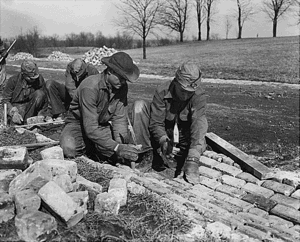 |
 |
| CCC workers constructing a road, 1933 |
CCC camps in Michigan; the tents were soon replaced by barracks built by Army contractors for the enrollees.[6] |
Conservation Corps State Museum
Camp San Luis Obispo, formerly called Camp Merriam, was established in 1928 and is called the original home of the California National Guard. The camp is in San Luis Obispo County, which is on the Central Coast of California. State Route 1 passes through the camp about halfway between the cities of Morro Bay and San Luis Obispo. Since World War II, the camp has had an area of 15,433 acres (62 km2).[2] The camp originally comprised 6,274 acres (25 km2), and a further 9,159 acres (37 km2) was acquired during 1941. During World War II, the camp had quarters for 1,523 officers and 19,383 enlisted personnel.[2]
The Conservation Corps State Museum is located in four barracks buildings on the grounds of Camp San Luis Obispo. Opened in 1995, the museum exhibits the works of the Civilian Conservation Corps (CCC) in California. One building is a replica of a 1930s CCC barracks, including tools, uniforms and other artifacts. The museum is open by appointment. It contains the library and research center of the National Association of Civilian Conservation Corps Alumni Buildings.
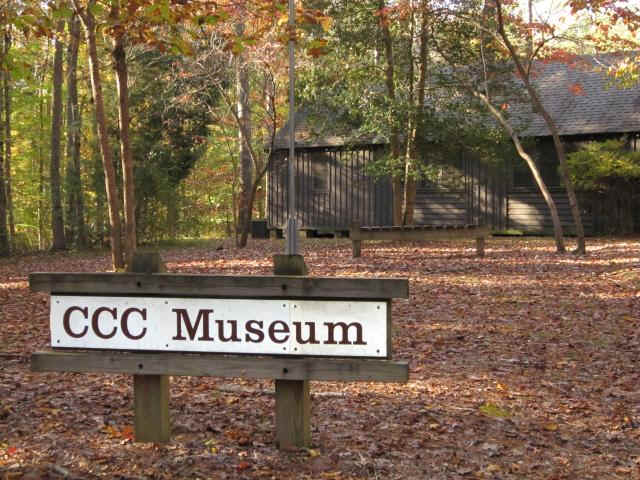 |
 |
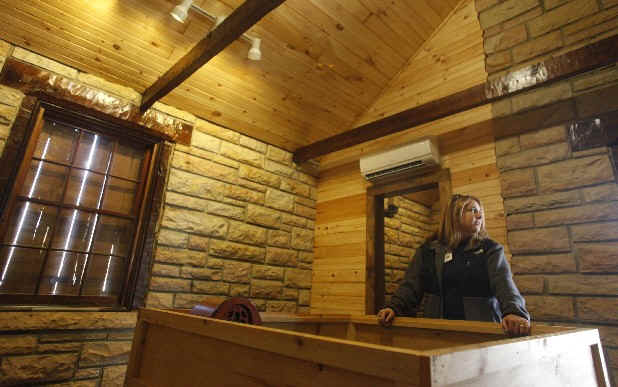 |
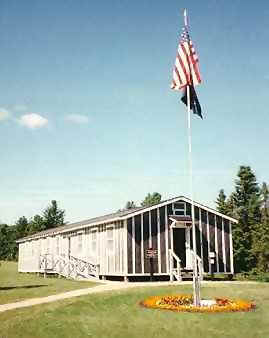 |
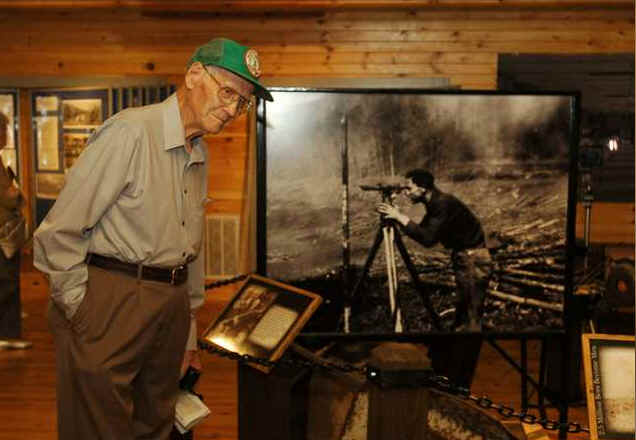 |
 |
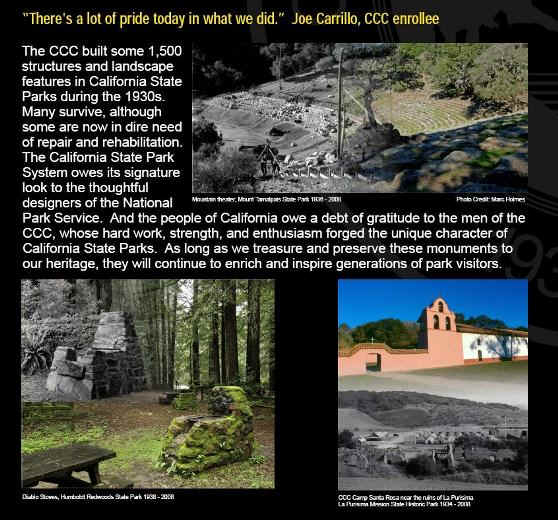 |
 |
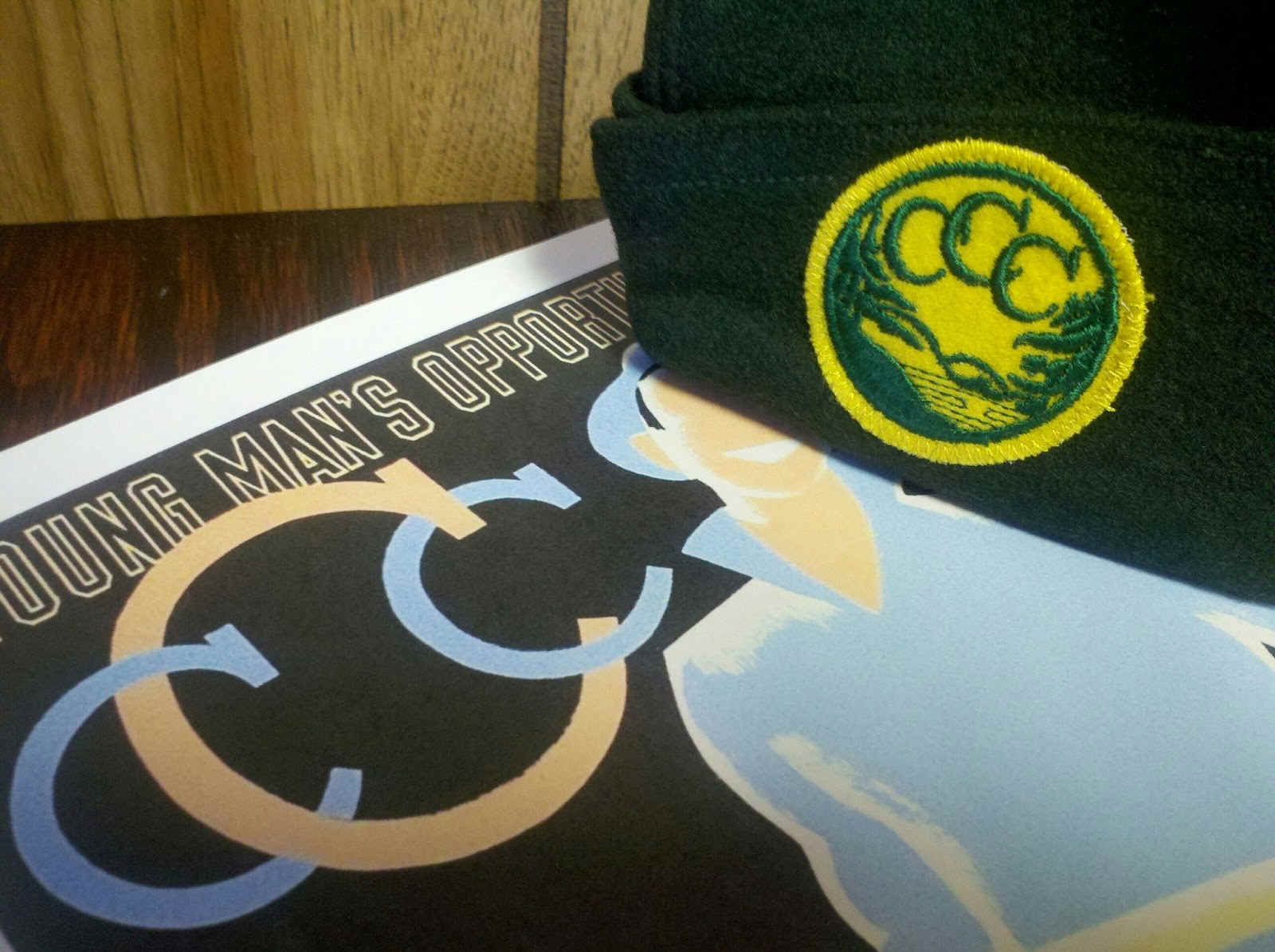 |
 |
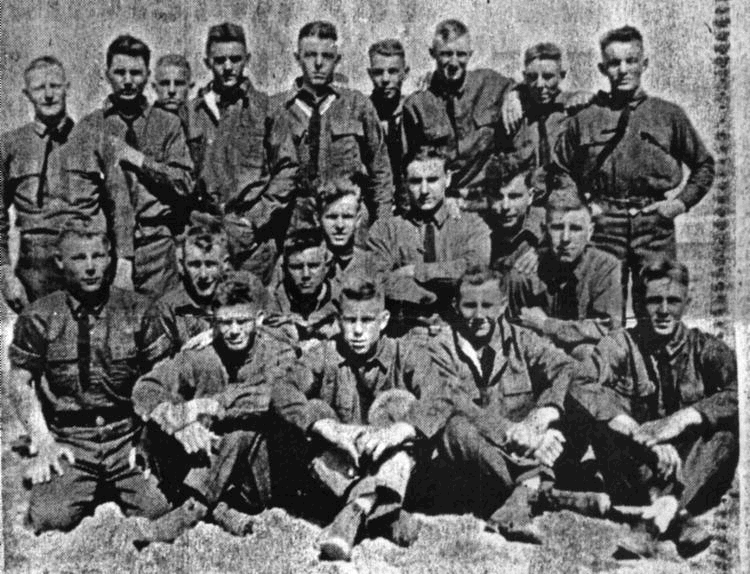 |
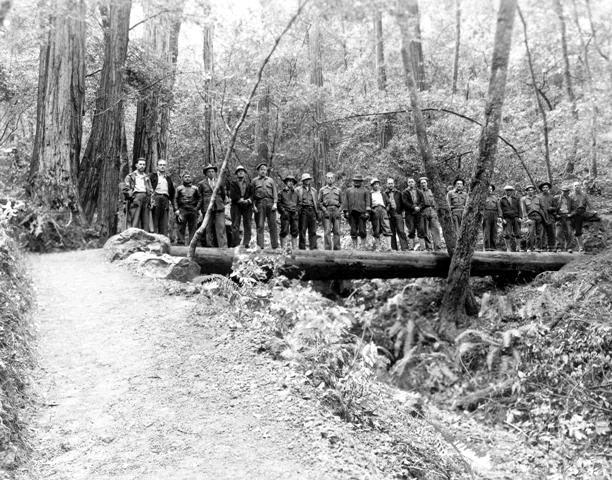 |
CCC planting crew members at Camp Humboldt Redwoods in 1935. |
Featured State Parks: Mount Diablo Big Basin Redwoods Mount Tamalpais Humboldt Redwoods La Purisima Mission Pfeiffer Big Sur Mount San Jacinto Cuyamaca Rancho |
|
In California, the legacy of the Civilian Conservation Corps (CCC) can be found in our State Parks. The CCC developed the infrastructure for the young park system, from unique projects such as the reconstruction of Mission La Purisima Concepcion, to planting trees and landscaping. Californians have a profound sense of gratitude to the visionary government leaders and the hard working young men of the three C's. In 2008, California State Parks commemorated the 75th anniversary of the establishment of the Civilian Conservation Corps. These online presentations along with the many historic photographs describe the work of the CCC and its contributions to our Golden State. |
Civilian Conservation Corps in California State Parks |